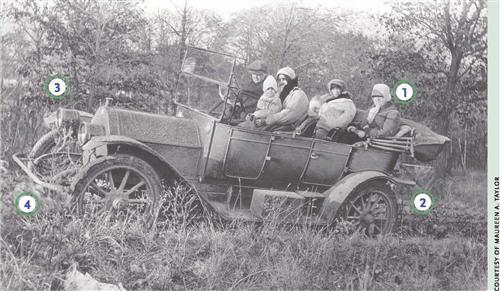Sign up for the Family Tree Newsletter Plus, you’ll receive our 10 Essential Genealogy Research Forms PDF as a special thank you!
Get Your Free Genealogy Forms
"*" indicates required fields

They say your choice of automobile reveals something about you: Jeep owners are adventurous; a minivan shows you’re practical. But if you have an old family photo featuring a cal; such as this shot of the Millar family of Minneapolis, you’ll extrapolate even more than personality traits. By studying the bumpers, headlamps and chassis, you can learn details such as when and where your ancestors purchased their car and their economic status. And yes, you’ll find out a little something about the man behind the wheel (or perhaps a progressive woman; our mothers and grandmothers rarely drove in the early 1900s).
Sentimental journey
Humans invented the first “car,” a steam-powered wheeled platform, in the late 18th century. Gasoline and electric autos didn’t appear until 100 years later; Karl Benz (who helped found the company that became Mercedes-Benz) patented a vehicle in 1886. It took awhile for these new contraptions to pick up speed-not many people could afford them and availability was limited. In 1900, fewer than 10,000 Americans traveled the roads in “horseless carriages.” But by 1920, 8 million people owned cars.
More than 240 US automakers existed in 1910, offering models largely unknown today. (See a list of manufacturers at < en.wikipedia.org/wiki/List_of_automobile_manufacturers#US-automakers>) Many went out of business or merged into the companies we know, but your ancestor’s car may have been produced close to home. Use city directories to learn the names of nearby auto manufacturers. For instance, according to business listings in a 1913 Minneapolis city directory, the Millars could have chosen from more than 50 local automobile manufacturers and dealers.
If you don’t know when your photo was taken and therefore, which year’s directory to check use clothing to establish a date. (It’s dicey to base dates on cars, since families kept them for years.) For help, see the August 2004 Family Tree Magazine and a book such as Dressed for the Photographer by Joan L. Severa (Kent State University Press).
By design
Let automotive design pave the way to a date range for your ancestors’ set of wheels, which will help you narrow the make and model. The first autos resembled fancy upholstered wagons (usually windshieldless) with a center tiller or a wheel, but by 1910, cars had longer bodies and back seats. Occupants wore long coats, hats and goggles to protect themselves from dust and bugs. By the 1930s, the boxy shape was replaced by sleek lines such as those on the 1933 Duesenberg (see one at <www.hubcapcafe.com/ocs/pages01/dues3301.htm>). Vehicles of the 1950s are distinctive, with long bodies and fins.
Examine key features of the car in your picture: fenders, steering wheel or tiller, wheels, windshield and headlights. Compare them to cars in guides such as The Complete Encyclopedia of Motorcars edited by G.N. Georgano (E.P. Dutton & Co.) or The Ultimate Auto Album by Tad Burness (Krause Publications). Look up later-model autos in Burness’ American Car Spotter’s Bible, 1940-1980 (Krause Publications). Also visit the Museum of Automobile History Web site <www.themuseumofautomobilehistory.com> and run a Google <google.com> search on a make.
The Millars’ car, with a square seating area, removable windshield and lantern-like headlamps, dates from about 1913. It shares many features of 1912 Chalmers and Lion touring cars, including the size and shape of the wheels, seats and windshield, and the placement of the steering wheel on the car’s right. The fold-down top could be used in inclement weather.
Easy street
Once you’ve guessed a make and model, read about the car’s price in one of the aforementioned references. In 1912, most cars cost between $2,000 to $3,000. Ford Model Ts went for about $850. They were sold without tires, fenders, tops, windshields and lights-all special order accessories. By the 1920s, assembly line production had helped drive the price down around $300.
The Chalmers sold for $1,800, with the top and windshield adding $100. According to the Inflation Calculator <www.westegg.com/inflation>, a $2,000 car in 1912 is the equivalent of $41,000 in 2006. A family had to be pretty comfortable to afford that ride.
Looking Under the Hood
1 Style notes. Clothing helps date the photo, but not necessarily the car.
2 lour deal. Auto-related business listings in city directories help you guess a make and model.
3 Lights on. Compare the car’s features with automotive reference books to pinpoint a model and manufacture date.
4 License to drive. Look for a license plate, which can give a year, place and owner’s initials.
From the July 2007 issue of Family Tree Magazine.
ADVERTISEMENT

